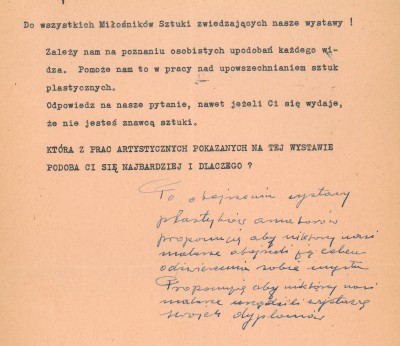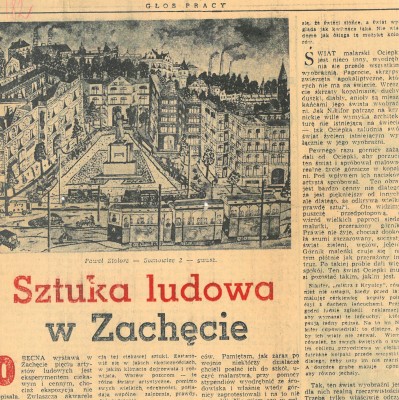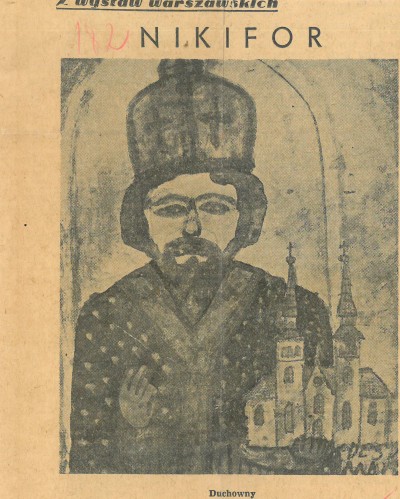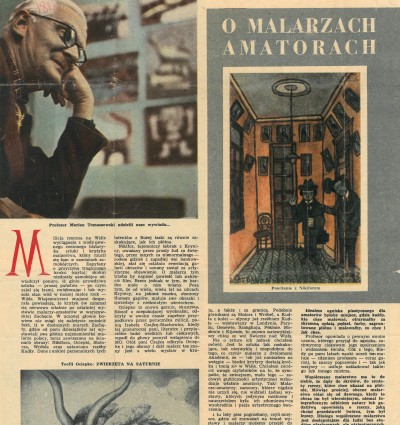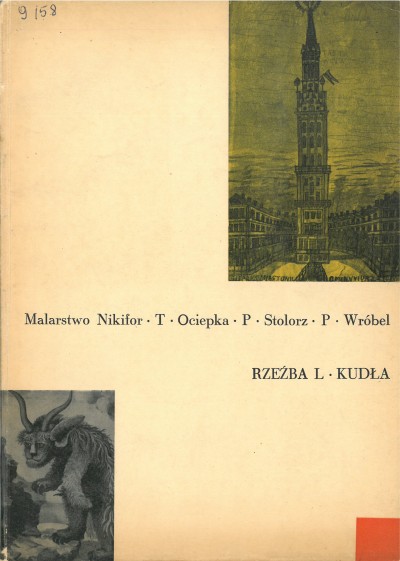Nikifor, Teofil Ociepka, Paweł Stolorz, Paweł Wróbel (painting), Leon Kudła (sculpture)
31.07 – 31.08.1958 Nikifor, Teofil Ociepka, Paweł Stolorz, Paweł Wróbel (painting), Leon Kudła (sculpture)
Zachęta Central Bureau of Art Exhibitions (CBWA)
organiser: CBWA, ZPAP
commissioner: Ewa Śliwińska
number of works: 274
attendance: 6.460 (Rocznik CBWA [CBWA Annual])
Reviews of this exhibition from August 1958 highlighted the fact that it was an ‘artistic sensation of Warsaw’[1] and that ‘Teofil Ociepka and two of his painter friends, Paweł Wróbel and Paweł Stolorz, truly became a revelation in Warsaw’.[2] The first such an extensive exhibition of naïve — or non-professional — art at the CBWA featured 183 works by Nikifor, twenty-some works by Teofil Ociepka, Paweł Stolorz and Leon Kudła, as well as 17 paintings by Paweł Wróbel. The exhibition at the Zachęta was preceded by Nikifor, mistrz z Krynicy (Nikifor, master from Krynica), a publication by Andrzej Banach released in 1957,[3] and followed by a series of individual international exhibitions of the ‘Matejko’ from Krynica (in Paris, Amsterdam, Brussels, Liége in 1959, in Haifa in 1960, in Vienna, Baden-Baden, Frankfurt am Main, and Hannover in 1961).[4]
The scenario of the 1958 exhibition tells us that the choice of a title encompassing only the artists’ names was a conscious choice, which also resulted from the short preparation time: ‘The main objective of this exhibition . . . is not . . . to show the problem in a full and cross-sectional way, but to highlight the works of a number of authors who deserve to be recognised as creative painters. . . . at the same time, their works can be collected in the short time required by the CBWA. . . . I motion not to name it [the exhibition — GŚ] using any slogan or motto that would evaluate their “primitiveness” or “naïveté” (these are the terms of intelligentsia, who want to affirm their own selves, their knowledge and their own attitude to the world), but simply: Exhibition of the works of Nikifor, Ociepka, Stolorz and Wróbel, or Ociepka, Nikifor, Stolorz, Wróbel — “uneducated painters.”’[5]
The final and official title of the exhibition did not include the term ‘uneducated painters’, and yet the theme of non-professional art dominated the communication concerning the exhibition — the works of naïve artists were repeatedly contrasted and juxtaposed with academic education.
Słowo Powszechne commented on the exhibition: ‘For the first time in history, the doorsteps of Zachęta, which for many years has been officially considered a salon of art with a capital A, were crossed by artists who have never studied in universities and art schools, artists commonly referred to as naïve.’[6] The reviewer writing for Lublin-based Kamena had similar things to say about the exhibition: ‘The road to art does not always lead through art academies. . . . sometimes, a painting made by a folk artist — unconsciously primitive, showing ineptitude in mastering the basic principles of artistic craftsmanship — can be more moving than a deliberate, consciously intended primitiveness of a professional artist.’[7] At the same time, the reviewers emphasised the importance of art and community centres, where — unlike art schools and universities — there were no ‘enemies of spontaneous folk talent’ and everyone paints ‘what they want and how they want to do it.’[8]
Before 1958, the CBWA did not organise extensive exhibitions of works by non-professional artists, although it would seem fitting in well with official national politics. In 1946 the Voivodeship Culture Council in Katowice organised an exhibition of works of over eighty amateur artists.[9] It should be noted here that in official debates of the People’s Polish Republic, amateur art was considered to be an important element of ‘new forms of socialist culture,’ as described by Aleksander Jackowski in a text published in 1980, summing up the experiences from the organisation of the Amateur Visual Art Triennial in the 1970s.[10]
The exhibitions of art, which may be described as ‘non-professional’ or ‘amateur’, organised at the Zachęta in Warsaw before 1958 included the exhibitions of paintings by Felicja Głowacka (June–July 1957) and Hel Enri (May 1958, Kordegarda.) However, it should be noted that the social status and contacts with the artistic community of both painters would be hard to compare with the circle of Silesian painters (Teofil Ociepka, Paweł Stolorz, Paweł Wróbel), members of the Janowska Group, working in the ‘Wieczorek’ mine. The works by Felicja Głowacka (1896–1953), born in Warsaw to an intelligentsia family of a dentist, wife of graphic artist Edward Głowacki, who was a friend of the sculptor Zofia Woźna, were appreciated by Helena Blum in 1950, and by Ignacy Witz and Jerzy Wolff after a posthumous exhibition at CBWA.[11] Meanwhile, in a review published in 1966, Witz claimed that it would be hard to consider Hel Enri (Helena Berlewi, 1873—1976), Henryk Berlewi’s mother, to be a naïve painter.[12] The exhibition of Hel Enri’s works in Kordegarda was organised four years after her artistic debut at Galerie M. Bénézit in Paris (1954), and the text in a catalogue accompanying the Warsaw exhibition was written by one of the most eminent experts on naïve art, Anatole Jakovsky.[13]
It was therefore no coincidence that the early draft of a scenario of an exhibition of five artists from 1958 (entitled Nikifor — Ociepka — Stolorz — Wróbelin May of that year) preserved in the Zachęta department of documentation included some doubts as to whether the works by Głowacka or Hel Enri should be included. Eventually, the concept of ‘letting a number of creative authors, already known in our artistic circles, but generally unknown to the broader audiences and the society of Warsaw, have their say’ prevailed.[14]
The most noteworthy aspects of the history of the reception of the 1958 exhibition include not only the large number of reviews, mentions and reproductions of works published in the national dailies, but also a significant number of mentions in literary and artistic magazines — the CBWA 1958 Annual lists about 40 publications, not counting mentions or reproductions of works.[15] Among the numerous opinions on the exhibition, one in which naïve art was juxtaposed with the contemporary modern painting trends is particularly worth recalling: ‘In the time, when state galleries accept the most bizarre abstract and tachisme exhibits without any qualms or reservations, nobody is concerned about the legitimacy of Nikifor or Ociepka. In the absence of any other justification, they may even be presented as a chapter of contemporary Polish formism, which would correspond to the rank set for Douanier Rousseau, Vivin, Bombois and others within the framework of Western modern art.’[16] The quoted comments remind about the fact that the historical background for the exhibition of works by Nikifor, Ociepka, Stolorz, Wróbel and Kudła was the construction of the paradigm of modern art in the period of the political thawing. At the same time, in summer of 1958, the Study of Space was presented in Warsaw in the Salon of New Culture, which at that time were considered to be ‘shocking’, as the press claimed at the time, while today they are believed to be centrepieces of the canon of Polish modernism.[17]
While looking for the reasons for perfect reception of naïve art, Ignacy Witz tried to explain it with ‘the principle of contrasting phenomena.’ Naïve art is appreciated particularly when its simplicity is opposed to the ‘intellectualism’ of contemporary art:
‘Very often, when it comes to contemporary art, its intellectualism is aptly pointed out. Contemporary art . . . is deeply ingrained in theory . . . and from time to time, the principle of contrast within us demands something that opposes even the broadest norm. It is then that we begin to admire what is primitive, true and spontaneous naïveté, which we cannot afford ourselves, the ultimate simplicity, painting or sculpture full of the astonishing old folk tradition . . . This simplicity, pure and not contaminated with all that we breathe in art, allows us to react so strongly to the works of “naïve realists”.’[18]
Naïve art was not only presented in opposition to contemporary art; it was also understood as a continuation of realism — no longer as Socialist Realism, but as ‘naïve realism’. Many texts about the exhibition of works by Nikifor, Ociepka, Stolorz, Wróbel and Kudła, not necessarily written by well-known art critics, do not talk about aesthetic consideration as much as arguments that were still ‘ideologically correct’.
Characteristically, in many texts published in daily papers, the border between naïve art and folk art, primitive art and the art of miners, amateur artists and painters, valued during the reign of the Socialist Realist doctrine, was blurred. Let us look at a few review titles from 1958: Sztuka prymitywna [Primitive art], Sztuka ludowa [Folk art], Ludowi realiści [Folk realists], Naiwni realiści [Naïve realists], Artyści ludu [Artists of the people], Malarze-górnicy [Miners-painters], Górnicy-artyści [Miners-artists], O malarzach amatorach [On amateur painters]. The authors, often hiding behind initials or pseudonyms (like the one from Orka magazine) reminded the readers in 1958 that the ‘first exhibition of works by amateur miners’ opened in 1949’ was also a great artistic sensation in Warsaw.[19] Perhaps it was influenced by the fact that the title of the exhibition at the CBWA did not suggest any name or any attempt at a synthetic approach to the phenomenon of naive art. Such an attempt was only made by Aleksander Jackowski in his work on the exhibition Others. From Nikifor to Głowacka, who struggled with the name of the phenomenon and its heterogeneity — it encompassed folk art, works by professional groups, such as miners, great individuals, and naive art ‘exploding’ in adulthood.[20]
The 1958 exhibition was important for the reception of naïve art in Poland, but Jackowski’s exhibition — Others. From Nikifor to Głowacka was much more coherent conceptually. The art by Nikifor, Ociepka, Stolorz, Wróbel and Kudła can be described as ‘peripheral’ against the backdrop of the main avant-garde currents and academic art. On the other hand, however, since the 1880s, when Henri ‘Douanier’ Rousseau began to submit his paintings to the Salon des Indépendants, l’art naïf was included among other modern trends in art. The latter tendency, namely placing naïve art at the centre of historical and artistic interests, was also well reflected in Polish publications. The Contemporary Polish Painting series, apart from compilations devoted to Tadeusz Brzozowski, Jan Cybis, Jan Lebenstein, Jerzy Nowosielski, Piotr Potworowski, Henryk Stażewski and Andrzej Wróblewski, also included compilations of works by Paweł Stolorz (1964) and Teofil Ociepka (1967).[21] These days, we are not always able to find a place for naive art in the constructed paradigm of Polish modern art while looking at it from a distance — not only as a local or regional specificity (as is the case with the collection of amateur art in the Silesian Museum in Katowice.) We can, however, try to define the reasons for the gradual divergence of the paths of naïve art and modern art, which can be observed for example in the Central Bureau of Art Exhibitions exhibition programme in the 1970s.
The works by Ociepka, Stolorz and Wróbel returned to the CBWA as part of Aleksander Jackowski’s exhibition entitled Others. From Nikifor to Głowacka in 1965.[22] In June of the same year a posthumous exhibition of Leon Kudła’s (1879–1964) sculptures was opened in Kordegarda,[23] while Nikifor, in addition to an exhibition which took place as part of Jackowski’s project, had a large retrospective exhibition in the main building of Zachęta in June 1967.[24]
Gabriela Świtek
Institute of Art History of the University of Warsaw
This compilation was prepared as part of the National Programme for the Development of Humanities of the Polish Minister of Science and Higher Education — research project The History of Exhibitions at Zachęta — Central Bureau of Art Exhibitions in 1949–1970 (no. 0086/NPRH3/H11/82/2016) conducted by the Institute of Art History of the University of Warsaw in collaboration with Zachęta — National Gallery of Art.
[1] J. T., ‘Nikifor, Ociepka i inni’, Tygodnik Powszechny, no. 35, 1958, p. 6.
[2] WISZ, ‘Notatki i utarczki. Utoplec i warszawiacy’, Trybuna Robotnicza, no. 193, 1958, p. 3.
[3] Cf. A. Banach, Nikifor, mistrz z Krynicy, Kraków, 1957.
[4] See the exhibition calendar in Nikifor, June 1967, exh. cat., ed. J. Zanoziński et al., Warsaw: Centralne Biuro Wystaw Artystycznych, 1967, n.pag.
[5] Cf. E. Śliwińska, Nikifor — Ociepka — Stolorz — Wróbel, exh. scenario, department of education (manuscript, 31 May 1958), Nikifor, Teofil Ociepka, Paweł Stolorz, Paweł Wróbel (painting), Leon Kudła (sculpture), 1958 exh. documentation, documentation department of Zachęta — National Gallery of Art, Warsaw.
[6] ‘„Naiwni” w Zachęcie’, Słowo Powszechne, no. 182, 1958, p. 6.
[7] B. Borowiak, ‘Człowiek na Saturnie’, Kamena (Lublin), no. 18, 1958, p. 5.
[8] Zadrjan, ‘O malarzach amatorach’, Nowa Wieś (Warsaw), no. 38, 1958, p. 4 [the text contains excerpts from an interview with Marian Tomaszewski, director of the Ognisko Plastyczne in Warsaw].
[9] Cf. S. A. Wisłocki, Mit, magia, manipulacja i orbis interior. Śląska sztuka nieelitarna, 2nd extended and amended edition, Katowice, 2008, p. 16.
[10] Cf. A. Jackowski, ‘Miejsce i rola plastyki amatorskiej w naszej kulturze współczesnej’, in Plastyka nieprofesjonalna, ed. A. Jackowski, Warsaw, 1980, p. 36.
[11] Cf. Wystawa Felicji Głowackiej, June–July 1957, exh. cat., Warsaw: Centralne Biuro Wystaw Artystycznych, 1958; H. Blumówna, ‘O malarstwie Felicji Głowackiej’, Tygodnik Powszechny, no. 17 1950, pp. 8–9; J. Wolff, ‘Felicja Głowacka’, Znak, no. 7–8, 1960, pp. 966–975; A. Jackowski, Sztuka zwana naiwną. Zarys encyklopedyczny twórczości w Polsce, Warsaw, 1995, pp. 60–61.
[12] Jackowski, Sztuka zwana naiwną…, p. 65.
[13] Cf. Hel Enri, exh. cat., Warsaw: Centralne Biuro Wystaw Artystycznych, 1958.
[14] Cf. E. Śliwińska, Nikifor — Ociepka — Stolorz — Wróbel exh. scenario, np. The issue of ‘social belonging’ of the artists noted in the scenario of the 1958 exhibition is mentioned in the text ’„Inni” w kanonie nowoczesności’, in Polska — kraj folkloru?, ed. J. Kordjak, Warsaw: Zachęta – Narodowa Galeria Sztuki, 2016, p. 172.
[15] Ibid., pp. 17–18. See also: Nikifor, Teofil Ociepka, Paweł Stolorz, Paweł Wróbel (painting), Leon Kudła (sculpture), 1958 exh. documentation, department of documentation of Zachęta — National Gallery of Art, Warsaw.
[16] Z. Kałużyński, ‘Wśród malujących w niedzielę’, Polityka, no. 38, 1958, p. 9.
[17] [Szoking w Warszawie po ostatniej wystawie Fangora stale jeszcze trwa!], “Pêle-mêle z kraju”, Kierunki, no. 34, 1958, p. 11; B. Kowalska, ‘Sezon ogórkowy w stołecznej plastyce, Ekran, no. 35, 1958, p. 10.
[18] I. Witz, “Naiwni. Przechadzki po warszawskich wystawach”, Życie Warszawy, no. 196, 1958, p. 6.
[19] M. W., ‘Baśń i realizm’, Orka, no. 32, 1958, p. 1.
[20] Cf. the outline of the 1964 exh. scenario, Institute of Art of the Polish Academy of Sciences, Warsaw, Aleksander Jackowski’s archive, ‘Others’ folder, 1965, Zachęta, To the Central Bureau of Art Exhibitions in Warsaw (4.10.1964). More on this subject, see: „Inni” w kanonie nowoczesności, in Polska — kraj folkloru, p. 174.
[21] Cf. Paweł Stolorz, ed. A. Ligocki, Warsaw, 1964; Teofil Ociepka, ed. A. Ligocki, Warsaw, 1967.
[22] Others. From Nikifor to Głowacka, exh. cat., Warsaw: Centralne Biuro Wystaw Artystycznych, 1965, n.pag.
[23] Cf. Leon Kudła, wystawa pośmiertna, June–July 1965, exh. cat., ed. J. Grabowski, Warsaw: Kordegarda, 1965.
[24] Cf. Nikifor, June 1967, exh. cat., ed. J. Zanoziński et al., Warsaw: Centralne Biuro Wystaw Artystycznych, 1967.
Bibliography
- Rocznik CBWA 1958. Warsaw: Centralne Biuro Wystaw Artystycznych, 1959
- Świtek, G. ‘Sztuka „peryferii” w centrum’, in Regiony wyobraźni. Peryferyjność w kulturze XIX–XXI wieku, ed. M. Lachowski. Warsaw, 2017, pp. 127–152
Source texts:
- Borowiak, B. ‘Człowiek na Saturnie’. Kamena (Lublin), no. 18, 1958, p. 5
- Do Centralnego Biura Wystaw Artystycznych w Warszawie (4 October 1964), outline of exhibition script from 1964. Instytut Sztuki PAN, Warsaw, Aleksander Jackowski archive, portfolio „Inni”, 1965
- EM MIR. ‘„Naiwni” realiści w „Zachęcie”, Kronika Kulturalna’. Współczesność, no. 23/13, 1958, p. 2
- (grt). ‘Wystawy sezonu ogórkowego — bez ogórków. Chińska „kursywa”. Dzieło sztuki ze złomu. Najlepszy dorobek „krynickiego Matejki”. Sława na europejską skalę’. Express Wieczorny, no. 170 (issue A), 1958, p. 6
- J. T. ‘Nikifor, Ociepka i inni’. Tygodnik Powszechny, no. 35, 1958, p. 6
- Kałużyński, Z. ‘Wśród malujących w niedzielę’. Polityka, no. 38, 1958, p. 9
- Kowalska, B. ‘Sezon ogórkowy w stołecznej plastyce’. Ekran, no. 35, 1958, p. 10
- Ledóchowski, S. ‘„Fujarkowe granie”’. Tygodnik Demokratyczny, no. 32, 1958, p. 8
- M. W. ‘Baśń i realizm’. Orka, no. 32, 1958, pp. 1 and 6
- Markiewiczowa, H. ‘Samorodne talenty’. Dziennik Zachodni (Katowice), no. 194, 1958, p. 5
- ‘„Naiwni” w Zachęcie’. Słowo Powszechne, no. 182, 1958, p. 6
- ‘Pêle-mêle z kraju’. Kierunki, no. 34, 1958, p. 11
- WISZ. ‘Utoplec i warszawiacy. Notatki i utarczki’. Trybuna Robotnicza, no. 193, 1958, p. 3
- Witz, I. ‘Naiwni. Przechadzki po warszawskich wystawach’. Życie Warszawy, no. 196, 1958, p. 6
- Wolff, J. ‘Felicja Głowacka’. Znak, no. 7–8, 1960, pp. 966–975
- ‘Wystawa prac górnika-malarza Teofila Ociepki’. Dziennik Zachodni (Katowice), no. 160, 1950, p. 2
- Zadrjan. ‘O malarzach amatorach’. Nowa Wieś (Warsaw), no. 38, 1958, p. 4
Additional compilations:
- Banach, A. Nikifor, mistrz z Krynicy. Kraków, 1957
- Banach, A. Ociepka, Warsaw, 1988
- Hel Enri, exh. folder. Warsaw: Centralne Biuro Wystaw Artystycznych, 1958
- Inni. Od Nikifora do Głowackiej, exh. cat. Warsaw: Centralne Biuro Wystaw Artystycznych, 1965
- Jackowski, A. ‘Miejsce i rola plastyki amatorskiej w naszej kulturze współczesnej’, in Plastyka nieprofesjonalna, ed. idem. Warsaw, 1980, pp. 26–82
- Jackowski, A. Sztuka zwana naiwną. Zarys encyklopedyczny twórczości w Polsce, Warsaw, 1995
- Jackowski, A. Świat Nikifora. Gdańsk, 2005
- Ligocki, A. Artyści dnia siódmego. Katowice, 1971
- Ligocki, A., ed. Paweł Stolorz. Warsaw, 1964
- Ligocki, A., ed. Teofil Ociepka. Warsaw, 1967
- Piwocki, K., Dziwny świat współczesnych prymitywów. Warsaw, 1975
- Świtek, G. ‘„Inni” w kanonie nowoczesności’, in Polska — kraj folkloru?, ed. J. Kordjak. Warsaw, 2016, pp. 171–181
- Wisłocki, S. A. Mit, magia, manipulacja i orbis interior. Śląska sztuka nieelitarna. Katowice, 2008 (2nd edition)
- Zanoziński, J., et al., eds. Nikifor, exh. cat. Warsaw, 1967
Nikifor, Teofil Ociepka, Paweł Stolorz, Paweł Wróbel (painting), Leon Kudła (sculpture)
31.07 – 31.08.1958
Zachęta Central Bureau of Art Exhibitions (CBWA)
pl. Małachowskiego 3, 00-916 Warsaw
See on the map
Thank you for your registration!
We have sent to your email address a link with a confirmation of registration.
Please click on the link in order to fully activate your account.
After registering on the service, you can add events and exhibitions that are important for you to your favourites. To your list of favourites you can also add objects from the collection, and from amongst the publications and multimedia library which we make available on our open Creative Commons licence. As a result you can download publications, books, films and many other materials.
Shortly you will be redirected to main page
